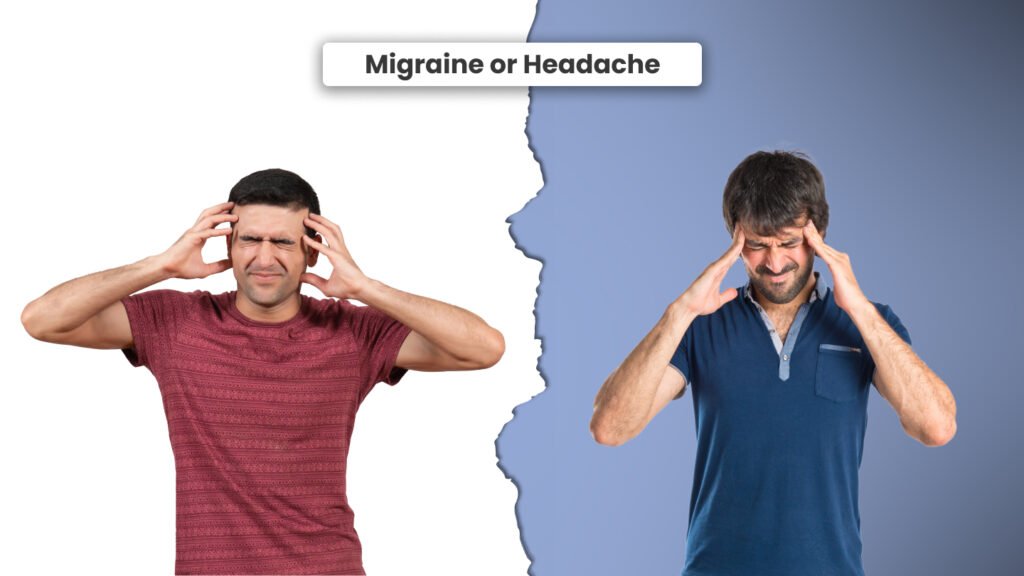Wondering if you’re dealing with a migraine or just a headache? Grasping the difference is key to obtaining fast and effective relief.
According to WHO Globally, headache disorders affect approximately 40% of the population, or 3.1 billion people in 2021, and are more common in females compared to males.
In northern India, several studies show that the headache prevalence rate is 63.9%. Females are disproportionately affected, experiencing headaches at a rate of 74.3%, while the rate for males is 32.6%. Additionally, the prevalence of migraine is 13.44%, also showing a higher occurrence in females, who account for 87.5% of cases.
Though people often use “headache” and “migraine” to mean the same thing, they can be different problems with unique features and ways to treat them. This blog will help you figure out if you have a migraine or just a headache and gives tips to feel better.

How to identify : Migraine or just a Headache
Headaches is mostly used as an umbrella term and it cover many types of pain in the head, scalp, or neck. They can hurt a little or can be unbearable sometimes and happen for different reasons.
Common types of headaches include:
-
Tension Headaches: Often caused by tight muscles and stress, these feel like a dull ache and tightness around the forehead or back of the head.
-
Cluster Headaches: Sharp pain around one eye coming in groups or cycles.
-
Sinus Headaches: Linked to sinus infections or stuffiness causing pain in the forehead, cheeks, and near the eyes.

Migraines are a distinct headache condition that causes repeated and often crippling pain with extra symptoms. They can last anywhere from a few hours to many days and tend to hurt more than other types of headaches.
Common types of migraine:
Two distinguishable types of migraine exist:
1. Migraine with aura
It has aura which is a warning of visual, sensory or motor type followed by a throbbing headache that is unilateral, exacerbated by strong light, eased by sleep, and sometimes accompanied by nausea and vomiting.

2. Migraine without aura
There’s no aura. Although the headache shares characteristics with tension headache, it is frequently poorly localized.

Main difference between migraine or just a headache:
◆Pain spot and intensity of pain : Headaches can pop up in different areas of head with or without involvement of neck areas, it can range from mild dull ache to severe throbbing pain, but migraines mostly cause bad severe throbbing pain on one side of the head.
◆ How long they last: Headaches might stick around for a few hours or all day, while migraines can last longer from 4 hours to 72 hours without treatment.
◆ Other Signs: Migraines often comes with nausea, vomiting and making you extra sensitive to light and noise. Headaches don’t come with these additional issues and aren’t as severe.
◆Triggering factors: Hormonal changes, certain foods, stress, and environmental factors can also trigger migraines. Stress, bad posture or tight muscles often lead to tension headaches.
Spotting these differences helps to figure out what kind of pain you’re dealing with and pick the right way to treat it.
Symptoms:
To figure out if you have a migraine or a headache, you need to look at certain symptoms.
Migraine Symptoms:
●Aura: Some people experience light gaze or blind spots minutes before a migraine hits. But not everyone experience aura.
●Pain: Migraines bring sharp pulsing pain. It often hits one side of your head, but sometimes both.
● Nausea: Many people with migraines feel nausea and might vomit.
●Extra Sensitive: Bright lights and loud sounds can bother you during a migraine.
●Trouble in vision : Your vision might get blurry or you might not be able to see for a bit.
Headache Symptoms:
➤Mild Pain: Headaches usually cause a dull ache and don’t hurt as much as migraines.
➤Tight Feeling: Tension headaches often feel like something’s squeezing your forehead or the back of your head.
➤No associated nausea : Unlike migraines regular headaches don’t make you feel nausea.
➤Less sensitive – sometimes headaches may also cause sensitivity to light and loud sound but it less than profound when it is compared to migraine.
Tracking these symptoms can aid in better understanding your condition and seeking appropriate treatment.
Underlining causes behind migraine or just a headache:
Headaches arise from muscles tension, sinuses drainage, more or less serious causes. Especially stress and posture are associated with tension headaches.
Migraine is classified as a neurological disorder that has a genetic component. Migraines involves complex brain changes and can be triggered by factors like hormonal changes, specific food items, and some environmental factors.

How they are diagnosed:
▶ Headaches are usually diagnosed by taking medical history and particularly considering the symptoms presented by patient. Mostly imaging tests are used not unless they have some severe or associated symptoms.
▶ Migraines involves a detailed assessment and evaluation with an extensive review of symptoms of patient. Sometimes imaging tests and neurological examinations are done to exclude other similar disorders and confirm migraine.
How they are managed :
Headache-
➥Over-the-counter medications– The first strategy to deal with them is using over-the-counter medications such as Aspirin or Ibuprofen. Be sure to read and adhere to the dosage instructions given by healthcare professional carefully to avoid any side effects.
➥ Stress management – Breathing exercises, meditation and regular exercises can help one manage stress levels properly hence reducing the frequency of tension headaches.
➥ Balanced diet and water– Additionally, if you are dehydrated or have low blood sugar levels it could trigger a headache hence one should always stay hydrated and eat balanced meals too.
➥ Posture – Maintaining good posture also helps prevent tension headaches especially if you spend long hours at the desk, an ergonomic design of your table might be a solution as well for your office workstation.
Migraine-
➥ Prescription Medications: Triptans and other prescription drugs can be effective for migraines. Consult a healthcare provider for suitable medication options and dosage.
➥ Preventive Medications: For frequent migraines, preventive treatments like beta-blockers, and other prescription medication may be prescribed to reduce attack frequency and severity.
➥ Medication for associated symptoms – Drugs are prescribed for nausea and other associated symptoms. There can be many different factors and associated symptoms effecting different cases, so the drugs and dosage can vary depending upon the case.
➥ Lifestyle modification –Identify and avoid migraine triggering factors, such as specific food items, stress, and environmental factors, can help. Keeping a consistent sleep schedule is vital for promoting overall health and well-being.
➥Alternative Therapies: Some individuals find relief from acupuncture, biofeedback, and cognitive-behavioural therapy.
The understanding of these differences helps to select suitable treatment options and handling the symptoms.
Self-Care Tips for Migraine or just a Headache:
● Cold or Hot Packs: Applying a cold pack to the forehead or the back of the neck can be an effective solution for relieving migraines.

●Rest in a dark, silent Room: Migraines are often exacerbated by light and sound, which means that resting in a dark, quiet place can help relieve symptoms.
●Hydrate: Make sure you take water to avoid dehydration since it may contribute to your headache.
● Gentle Stretching: Performing light stretches for the neck and shoulders can effectively reduce muscle tension associated with tension headaches.
●Deep Breathing: To reduce stress and tension, practice deep breathing exercises; this may relive headache pain.
When to seek professional help :
Although over-the-counter drugs and lifestyle changes can help with most headaches and migraines, it is necessary to see a doctor in some cases.
➣ Severe or Unusual Pain: If you experience unbearable or severe headaches or migraines, seek medical advice.
➣ Frequent Occurrences: Consult a healthcare professional if you frequently suffer from chronic pains or frequent headaches that interrupt your daily life.
➣ Neurological Symptoms: Immediate medical attention is needed if you are feeling these symptoms like sudden changes in vision, inability to speak properly, weakness or loss of sensation.
➣ No Response to Treatment: If the symptoms do not go away after self care or lifestyle modifications than consult to doctor.
Seeking early medical attention assists in avoiding complications and provides ways for the right treatment.
Prevention :
Preventing migraines and headaches requires a combination of lifestyle changes and proactive strategies. Here are some daily prevention tips:
➱ Proper sleep: Regular sleeping patterns help prevent sleep disturbances that could cause headache and migraine attacks.
➱ Control Stress: Include stress relieving activities such as exercises, mindfulness or hobbies in your routine.
➱ Stay Hydrated: Drink enough water all through the day to avoid dehydration headache related problems.
➱ Balanced Diet: Have a balanced diet while avoiding food triggers known to you; this helps regulate blood glucose levels at the same time. Eating regularly also helps keep blood sugar steady.
➱ Exercise Regularly: Physical activities can reduce tension headaches and improve overall body fitness by helping with stress reduction.
Role of physiotherapy in managing Headache and Migraine :

Tension headaches and migraines, especially those caused by muscle stiffness and bad posture, can be treated well with physiotherapy. Here are some ways in which physiotherapy manifests its usefulness:
➥ Relaxation Techniques: Tension headaches caused by muscle tightness can be eased by physiotherapists using methods like soft tissue manipulation, myofascial release and stretching to release tight muscles in the neck, shoulders, and upper back.
➥ Postural Training: Regularly maintaining good posture can help in the prevention or reduction of tension headaches. In this regard, physiotherapists teach exercises which are aimed at maintaining good alignment and postural integrity also they helps in making ergonomic adjustments.
➥ Education and Self-Care: Knowing about the problem reduces the chances of worsening, Physiotherapists educate patients about their condition along with body mechanics and deviations of posture of the patient.
➥Biofeedback: People experiencing migraines can utilize biofeedback, an evidence-based method that improves the ability to consciously control involuntary bodily processes. It helps in guiding patient to reach optimal performance.
Effective treatment and management of headaches and migraines can be achieved by knowing their differences. Headache is an umbrella term that encompasses all types of head pain but a general headache and migraine have different causes and treatments.
Knowing the exact signs and symptoms along with triggering factors relating to each one will help you to provide more specific relief. Self-care practices, seeking out the professional advice when necessary, as well as physiotherapy could also assist greatly in easing these symptoms or preventing them from getting worse.
Note – Never take any medicine without consultation of doctor

- https://www.ninds.nih.gov/health-information/disorders/migraine#:~:text=Symptoms%20include%20headache%20pain%20that,light%2C%20sound%2C%20or%20noise.
- How to tell the difference between migraine and headaches
- Migraine and other headache disorders
- Nandha R, Chhabra MK. Prevalence and clinical characteristics of headache in dental students of a tertiary care teaching dental hospital in Northern India. Int J Basic Clin Pharmacol 2013;2:51-5.

